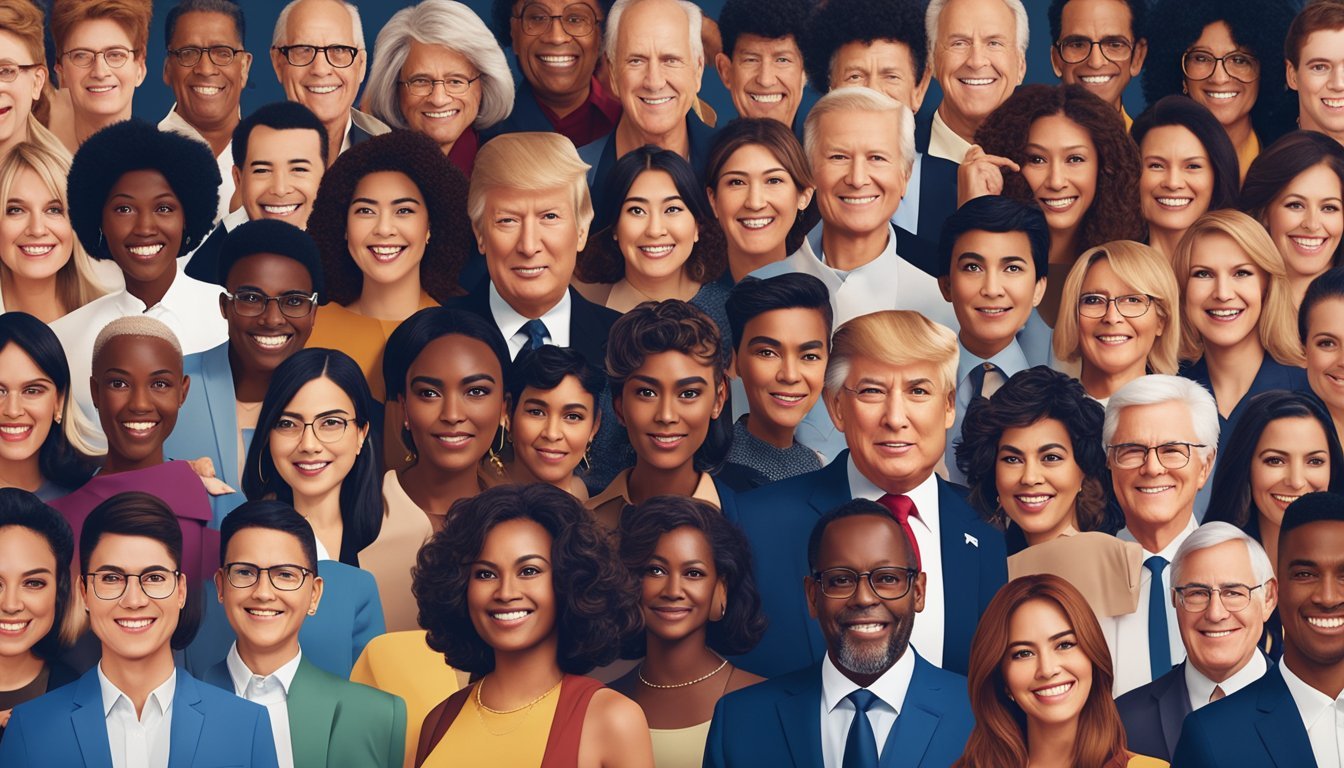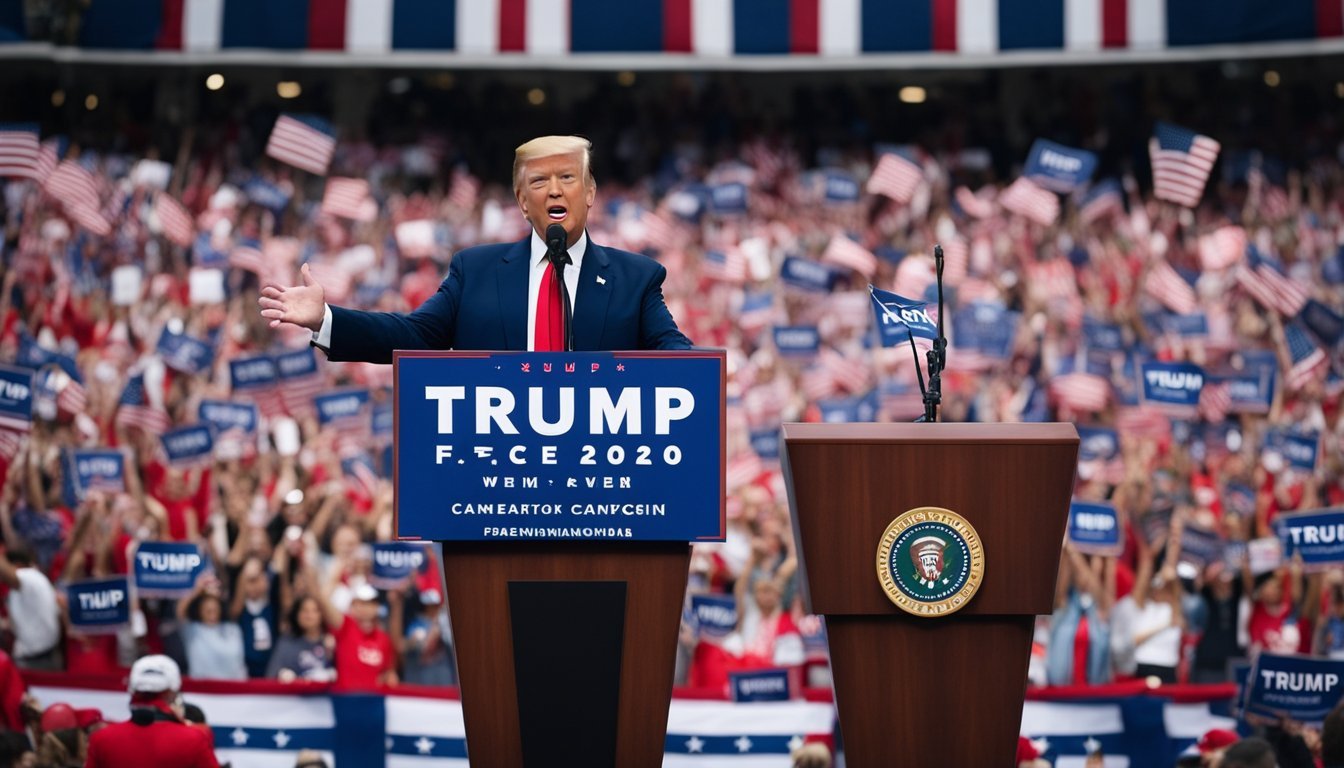Inside Donald Trumps Contentious 2020 Reelection Bid
Key Strategies and Challenges
Donald Trump's 2020 presidential campaign began unusually early, with the incumbent filing for re-election on January 20, 2017 - the same day he was inaugurated as the 45th President of the United States. As a member of the Republican Party, Trump sought a second term in office amid a backdrop of significant national and global challenges.
The campaign faced unprecedented circumstances, including the COVID-19 pandemic, economic turbulence, and social unrest. These factors reshaped traditional campaigning methods and forced adaptations to reach voters. Trump's re-election bid emphasized his first-term accomplishments and promised continued focus on issues like immigration, trade, and economic growth.
Despite his efforts, Trump ultimately lost the 2020 election to Democratic challenger Joe Biden. The aftermath of the election was marked by Trump's unfounded claims of widespread voter fraud, leading to legal challenges and heightened political tensions. This contentious period culminated in the events of January 6, 2021, at the U.S. Capitol, which continue to have lasting implications for American politics.
Campaign Launch and Key Policies
Donald Trump officially launched his 2020 reelection campaign on June 18, 2019 at a rally in Orlando, Florida. He focused on key policy areas like the economy, immigration, healthcare, and national security as central pillars of his platform.
Announcement and Republican Endorsements
Trump announced his reelection bid under the slogan "Keep America Great." The campaign kickoff rally drew thousands of supporters to the Amway Center. Top Republican leaders and officials quickly endorsed Trump's candidacy, solidifying his position as the presumptive GOP nominee.
The Republican National Committee voiced strong support for the president's reelection efforts. Trump's campaign emphasized his first-term accomplishments and promised to continue his policy agenda if given a second term in office.
Policy Overview: Economy and Immigration
Trump's economic platform centered on extending the 2017 tax cuts, pursuing deregulation, and renegotiating trade deals. His campaign highlighted low unemployment rates and stock market gains during his first term.
On immigration, Trump pledged to:
Complete construction of a border wall with Mexico
Implement stricter vetting for immigrants and refugees
End "chain migration" and the visa lottery system
Shift toward a "merit-based" immigration system
Policy Overview: Healthcare and Security
Trump vowed to repeal and replace the Affordable Care Act. His healthcare proposals included:
Lowering prescription drug prices
Increasing price transparency
Expanding health savings accounts
On national security, the campaign emphasized:
Increased military spending
Withdrawing troops from overseas conflicts
Pressuring NATO allies to boost defense budgets
Taking a hard line on Iran and North Korea
Trump also promised to appoint conservative judges to federal courts and protect Second Amendment rights.
Campaign Infrastructure and Strategy
Donald Trump's 2020 reelection campaign utilized a blend of traditional and modern tactics. The campaign focused on leveraging social media, holding large rallies, and aggressive fundraising efforts.
Campaign Management and Structure
Brad Parscale initially led Trump's 2020 campaign as campaign manager. He oversaw the development of a data-driven strategy and digital infrastructure. In July 2020, Bill Stepien replaced Parscale, shifting focus to more traditional campaign methods.
The campaign maintained a lean staff structure compared to previous presidential campaigns. It relied heavily on the Republican National Committee for ground operations and voter outreach.
Trump's campaign emphasized a "Keep America Great" message, building on his 2016 "Make America Great Again" slogan. The strategy aimed to energize his base and highlight his administration's accomplishments.
Fundraising Efforts
Trump's campaign employed aggressive fundraising tactics, utilizing email marketing and text messaging to solicit donations. The campaign raised significant funds, but spent money quickly on advertising and legal fees.
Joint fundraising efforts with the Republican National Committee boosted overall financial resources. However, the campaign faced cash flow challenges in the final months of the election.
Despite these efforts, Trump's campaign had less cash on hand compared to Biden's campaign in the crucial final stretch of the race.
Use of Social Media and Rallies
Trump's campaign heavily utilized social media platforms, particularly Twitter, to communicate directly with supporters. The president's personal Twitter account served as a primary channel for campaign messaging and attacks on opponents.
Large-scale rallies remained a cornerstone of Trump's campaign strategy, even during the COVID-19 pandemic. These events aimed to energize supporters and generate media coverage.
The campaign also invested in targeted digital advertising on platforms like Facebook and Google. This approach allowed for precise messaging to key voter demographics in swing states.
Voting Demographics and Targeted Messaging
Donald Trump's 2020 campaign focused on appealing to specific voter groups through tailored messaging. The campaign aimed to maintain and expand support among key demographics that helped propel Trump to victory in 2016.
Appeal to Specific Voter Groups
Trump's campaign prioritized outreach to white men, a group that strongly supported him in 2016. Exit polls showed Trump won 53% of male voters in 2020. The campaign also sought to increase support among minority voters, particularly Black and Hispanic Americans.
Trump emphasized his "America First" agenda to appeal to working-class voters in swing states. His campaign highlighted pre-pandemic economic gains and his stance on trade deals as beneficial for American workers.
Efforts were made to shore up support among older voters, who typically lean Republican. The campaign stressed Trump's commitment to protecting Social Security and Medicare.
Messaging Strategy and Slogans
"Make America Great Again" remained a central campaign slogan, with the addition of "Keep America Great" to emphasize Trump's first-term accomplishments. The campaign promoted the idea of continued economic growth and job creation under Trump's leadership.
Messaging focused on law and order, particularly in response to civil unrest in 2020. Trump positioned himself as a defender of public safety and police.
The campaign emphasized Trump's record of conservative judicial appointments, including three Supreme Court justices, to appeal to religious conservatives.
Digital advertising and social media played a significant role in spreading campaign messages. The Trump team invested heavily in targeted online ads to reach specific voter groups with tailored content.
Election Process and Results
The 2020 presidential election saw record-breaking turnout and unprecedented use of early and mail-in voting. Election Day unfolded amid the COVID-19 pandemic, with vote counting extending for days in key battleground states.
Early Voting and Mail-In Ballots
Early voting began in September 2020 in some states. Many jurisdictions expanded mail-in voting options due to COVID-19 concerns. Over 101 million Americans voted early, either in person or by mail.
Democrats utilized early voting at higher rates than Republicans. Trump voiced skepticism about mail-in ballots, claiming without evidence they would lead to fraud.
Several states experienced legal challenges over mail-in voting rules and deadlines. The Supreme Court allowed extended ballot receipt deadlines in Pennsylvania and North Carolina.
Election Day and Voter Turnout
November 3, 2020 marked Election Day across the United States. Despite the pandemic, in-person voting proceeded with safety measures like distancing and sanitization.
Voter turnout reached 66.8% of eligible voters, the highest in 120 years. Total votes surpassed 155 million, with Biden receiving over 81 million votes to Trump's 74 million.
Exit polls showed the economy as voters' top issue. Biden voters cited the coronavirus pandemic and racial inequality as key concerns.
Vote Counting and Margins
Initial results on election night showed Trump leading in several key states. As mail-in ballots were counted over subsequent days, Biden pulled ahead in crucial battlegrounds.
Pennsylvania's 20 electoral votes put Biden over the 270 threshold on November 7. He ultimately won 306 electoral votes to Trump's 232.
Final vote margins were narrow in swing states:
Arizona: Biden +0.3%
Georgia: Biden +0.2%
Wisconsin: Biden +0.6%
Trump disputed the results, filing lawsuits and requesting recounts in multiple states. Recounts and audits affirmed Biden's victory, finding no evidence of widespread fraud.
Key States and Electoral Margins
Donald Trump's 2020 campaign focused intensely on several crucial battleground states. These states played a pivotal role in determining the final electoral outcome.
Battleground States Analysis
Trump's campaign strategy centered on retaining key states he won in 2016. Pennsylvania, Michigan, and Wisconsin were top priorities, with Trump holding numerous rallies in these Rust Belt states. Florida and Ohio, traditional swing states, also received significant attention.
The campaign invested heavily in Arizona and North Carolina, aiming to keep them in the Republican column. Georgia, typically a reliable red state, unexpectedly became competitive. Trump made multiple visits to shore up support there.
Nevada and Minnesota were seen as potential pickup opportunities for Trump. His team increased outreach efforts in these states, hoping to flip them from blue to red.
Swing States Performance
Trump's performance in swing states was mixed. He successfully held Ohio and Florida, winning both by larger margins than in 2016. North Carolina also remained in Trump's column, albeit by a narrow margin.
Arizona and Georgia proved challenging. Both traditionally Republican states flipped to Biden by slim margins. Wisconsin, Michigan, and Pennsylvania - states Trump won in 2016 - all shifted back to the Democratic column in 2020.
Trump's campaign fell short in Nevada and Minnesota, failing to flip these Democratic-leaning states. The margins in many of these key states were incredibly tight, often decided by less than 1% of the vote.
Legal Challenges and Election Integrity
Donald Trump's 2020 presidential campaign faced numerous legal challenges related to claims of voter fraud and election integrity. These disputes played out in federal courts across the country and eventually reached the Supreme Court.
Claims of Voter Fraud
The Trump campaign alleged widespread voter fraud in several key battleground states. They pointed to mail-in ballots, voting machine irregularities, and ballot counting procedures as sources of potential fraud.
Election officials and cybersecurity experts repeatedly stated there was no evidence of significant fraud. Recounts and audits in contested states confirmed the original vote tallies.
Despite the lack of evidence, Trump and his allies continued to promote fraud claims. This sowed doubt about election integrity among many Republican voters.
Federal Court Cases
Trump's legal team filed over 60 lawsuits in federal and state courts challenging election results. Most cases were dismissed due to lack of evidence or legal standing.
Key rulings:
Pennsylvania: Court rejected claim that poll watchers lacked proper access
Michigan: Judge found fraud allegations "not credible"
Wisconsin: Supreme Court declined to hear Trump campaign lawsuit
The Trump campaign won a minor case in Pennsylvania related to ID requirements but it did not affect the outcome.
Supreme Court Involvement
The Supreme Court declined to hear several election-related cases brought by Trump allies. In December 2020, the Court rejected a Texas lawsuit seeking to overturn results in four battleground states.
In February 2021, the Court denied requests to fast-track election challenges from multiple states. Justices did not find merit in claims of widespread fraud or unconstitutional election changes.
These decisions effectively ended Trump's legal efforts to change the election outcome through the court system. The Supreme Court's refusal to intervene reinforced the legitimacy of Joe Biden's victory.
Public Response and Impact
Donald Trump's 2020 presidential campaign generated intense reactions across the political spectrum. It sparked passionate support from his base and fierce opposition from critics, while significantly impacting the Republican Party.
Reactions from Political Figures
Joe Biden, the Democratic nominee, criticized Trump's handling of the COVID-19 pandemic and racial justice issues. Biden portrayed himself as a unifying figure in contrast to Trump's divisive rhetoric.
Former President Barack Obama campaigned for Biden, arguing Trump was unfit for office. Obama highlighted the importance of protecting democratic institutions.
Some prominent Republicans, like Mitt Romney, distanced themselves from Trump. Romney voted to convict Trump during his first impeachment trial, breaking ranks with most GOP senators.
Public Rallies and Protests
Trump held large rallies despite COVID-19 concerns, drawing enthusiastic crowds of supporters. These events became a hallmark of his campaign, with attendees often echoing his claims about election fraud.
Protests erupted in many cities following the death of George Floyd. Trump's response to these demonstrations became a major campaign issue.
Counter-protests emerged, with Trump supporters clashing with Black Lives Matter activists in some locations. These confrontations heightened tensions during an already volatile election season.
Impact on Republican Party
Trump's campaign deeply influenced the Republican Party's direction. Many GOP candidates aligned themselves closely with Trump to appeal to his base.
The party platform was essentially replaced by a resolution to "enthusiastically support" Trump's agenda. This move underscored his dominance within the GOP.
Trump's claims of election fraud created rifts within the party. Some Republicans backed these assertions, while others accepted Biden's victory. This divide persisted after the election, shaping the party's future direction.
Post-Election Analysis
Donald Trump's actions and statements following the 2020 election sparked intense debate and scrutiny. Experts examined the results and their implications in detail, offering varied perspectives on the outcome.
Trump's Post-Election Statements
Trump repeatedly claimed the 2020 election was "rigged" and "stolen" despite a lack of evidence. He filed numerous lawsuits in key swing states, challenging vote counts and election procedures. Most cases were dismissed due to insufficient proof.
The former president held rallies and made media appearances, insisting he had won. He pressured state officials and the Justice Department to overturn results. These actions culminated in the January 6 Capitol riot as Congress certified Biden's victory.
Trump's refusal to concede broke with tradition and raised concerns about peaceful transfer of power. His statements eroded some supporters' trust in the electoral system.
Election Analysis by Experts
Election experts and officials found no widespread fraud that could have altered the outcome. Recounts and audits in contested states confirmed Biden's win.
Analysts noted shifts in key demographics that contributed to Trump's loss. Suburban voters and seniors moved away from Trump compared to 2016. Biden made gains with white voters without college degrees, a key Trump base.
Turnout reached record levels, with over 155 million votes cast. Biden received over 81 million votes, the most ever for a presidential candidate. Trump's 74 million votes were the second-highest total in history.
Polling errors underestimated Trump's support in some states, echoing 2016. This led to renewed scrutiny of polling methods and their reliability in predicting election outcomes.
Impact on Trump's Legacy
Donald Trump's presidency left an indelible mark on American politics and society. His unconventional approach to governance and polarizing rhetoric reshaped the political landscape, influencing both domestic and international affairs.
Presidency Overview
Trump's tenure was marked by significant policy shifts and a departure from traditional presidential norms. He implemented major tax cuts, appointed three Supreme Court justices, and renegotiated trade deals like NAFTA. His "America First" foreign policy led to changes in international relationships, including a more confrontational stance with China and NATO allies.
Trump's communication style, heavily reliant on social media, particularly Twitter, redefined presidential outreach. This direct approach energized his base but also drew criticism for its divisive nature.
The COVID-19 pandemic became a defining challenge of Trump's presidency. His administration's response, including travel restrictions and Operation Warp Speed for vaccine development, faced both praise and criticism.
Economic and Diplomatic Achievements
Trump's economic policies initially led to strong job growth and record-low unemployment rates. The stock market reached new highs during his term. His tax cuts and deregulation efforts were praised by supporters for stimulating economic growth.
Key diplomatic achievements included:
Brokering normalization agreements between Israel and several Arab states
Initiating direct talks with North Korea
Renegotiating trade deals with Canada, Mexico, and South Korea
Trump's tough stance on China resonated with many Americans concerned about trade imbalances and intellectual property theft. His administration also secured increased NATO spending commitments from allies.
Controversies and Impeachment
Trump's presidency was marked by numerous controversies that shaped public perception. He faced two impeachments - a first in U.S. history. The first, in 2019, centered on allegations of soliciting foreign interference in the 2020 election. The second, in 2021, followed the January 6 Capitol riot.
Other significant controversies included:
The Mueller investigation into Russian interference in the 2016 election
Separation of migrant families at the southern border
Disputes over the 2020 election results
Trump's handling of racial justice issues, particularly following the George Floyd protests, drew intense scrutiny. His response to the Charlottesville rally in 2017 also sparked widespread criticism.
The aftermath of the 2020 election, culminating in the January 6 events, became a defining moment of Trump's legacy, significantly impacting his standing among both supporters and critics.







